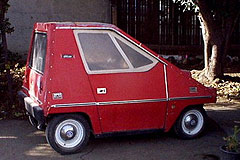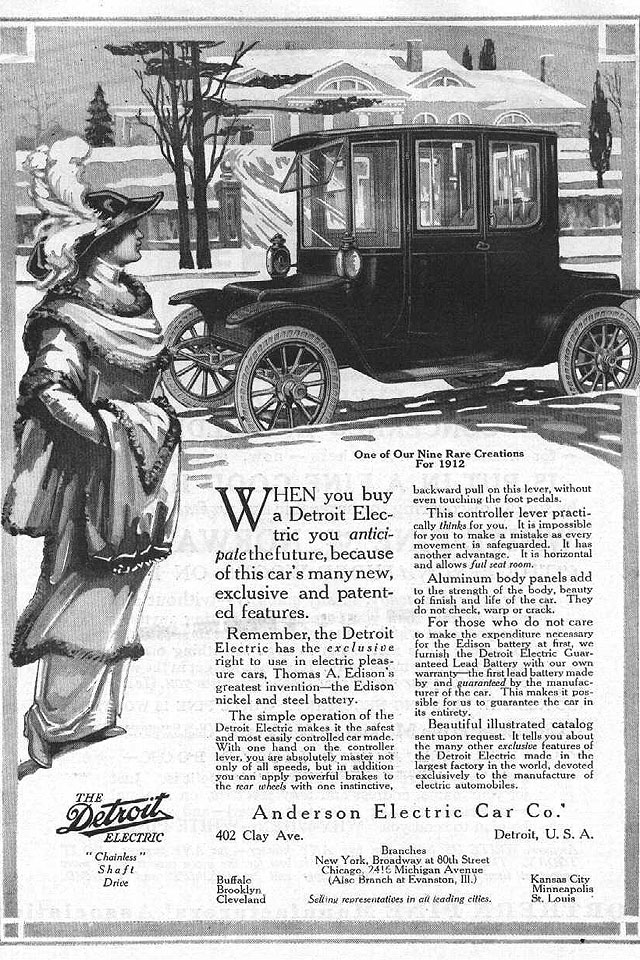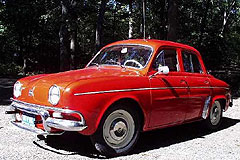Will electric vehicles ever become a serious contender in the automotive market? EV enthusiasts and environmentalists say yes. Much of the automotive industry has serious doubts. EVs, around from the very beginning of the auto age, have only been even reasonably successful in small niche markets.

The reasons for lack of interest are pretty much the same as almost a century ago, limited range, long recharge times and high cost. The millions automakers invested in the latest batch of electric vehicles like General Motors Impact, Ford's Ranger RV and Toyota RAV4-EV didn't go for naught. Much of technology, and especially, battery technology, was useful in the now how popular hybrids.
By the late 1890s, electric vehicles were quite well developed, at least in comparison to horseless carriages powered by internal combustion engines and steam. While gasoline fueled vehicles were still plodding along at a horse-like pace, electric ones were setting serious speed records. Camille Jenatzy of Belgium and his bullet-like "La Jamais Contente" achieved a record speed of 106 km/h (about 66 mph) in 1899, the first car to top the 100 km/h mark. Electric cars could travel upwards of 40 miles between charges. The early gasoline cars had to stop more frequently to add water for engine cooling.
Steam cars needed water, as well as, fuel frequently. By 1900, the Electric Vehicle Co. had put hundreds of its electric Hansom cabs, designed like the horse-drawn ones, on New York City streets.
The years between 1898 and 1912 were the high point of electric vehicles in America. Electrics had many advantages over their competitors in the early 1900s. They did not have the vibration, smell, and noise associated with gasoline cars. The electrics did not require gear changing, the most difficult part of driving gasoline cars.
Many manufacturers produced electric cars before World War I. The Pope Manufacturing Co. had produced some 500 Columbia electric cars by the end of 1898. General Electric began building electric cars in 1898 and Henry and Clem Studebaker, wagon builders since 1852, ventured into the automobile business in 1902 with a light, electric runabout several years before switching to gasoline-powered cars. In 1905, 86- percent of the cars sold in the U.S. were powered by gasoline; electric and steam each captured about 7-percent of the market, the most in all EV history.
The Detroit Electric car was the longest produced electric car, being manufactured between 1907 and 1942. It also was one of the most popular with more than 1,000 produced annually in some years prior to 1914. Production slowed down significantly in the 1920s and by the 1930s were they were only built to order. Electric powered car like the Detroit were popular with older women because they were clean, quiet and easy to drive. Perhaps most important, they did not have to be cranked to get them started . The women had to be wealthy since electric cars were very expensive in their day. In the mid-1910s, Detroit Electrics sold for about $3000, about four times the price of a Model T.

There are several reasons why the internal combustion engine won over electric and steam power. The simplistic answer often given is the invention of the electric starter by Charles "Boss" Kettering, which first appeared on the 1912 Cadillac. In reality, it was the advent of the cheap gasoline-powered car, most notably Henry Ford's Model T and the establishment of an infrastructure to keep them running.
In the early 1900's, electricity was still a novelty and usually only the wealthy could afford electricity in their homes. It was also expensive compared to gasoline electricity - about 20 cents per kW-hr versus 5 cents for a gallon of gasoline. Electric power plants were not standardized. Some generated DC power as favored by Edison, while others generated AC electricity as advocated by Tesla and Westinghouse. Furthermore, there was no standard DC voltage and yet no standard AC frequency. Also AC to DC rectifiers needed to charge batteries from AC power were still in their infancy and expensive.
Much of rural America would not be electrified until the 1930s and even as late as 1945. Unlike gasoline cars that could travel virtually anywhere, electrics were pretty much confined to urban areas. By 1905, gasoline was readily available, albeit still from general stores, carriage shops, smithies and liveries. By 1920, the gasoline pumps could be found throughout the country.
Further, limiting the electrics popularity was their high cost, range that did not improve to match that of the gasoline car, and relatively low top speed The range between recharges of only 30-50 miles, and in winter when batteries lost about 40 percent of their capacity. Also the poor roads of the day, frequently no more than cartpaths shared with horse-drawn vehicles, turned to mud fields in bad weather. Electric cars, with their heavy batteries, were at a great disadvantage when they had to pulled out of the mud. Another factor could have been the fact that because advertising for electric cars targeted women, men may have considered them a `woman's car.'"
By the mid-1930, electric vehicle production essentially ceased and serious interest would not return until the oil crises of the 1970s that coupled with concerns about cleaner air brought a need for alternative fuel. EV aficionados built electric cars in their basements and garages. Most of these were one-off conversions of regular cars and light trucks to electric power. Also EVs were commercially built, albeit in quite small quantities. For instance Vacuum cleaner manufacturer, Eureka-Williams, offered the Henney Kilowatt, a Renault Dauphine converted to run on 36-volt golf-car batteries. At $3,600 in 1961 some 120 were sold to electrical utilities, which used them mainly for meter readers.

When it comes to "mass" produced EVs, the Sebring-Vanguard Co. holds the record. It produced at least 2200 CitiCars in 1974-76. These tiny, wedge-shaped 2-passenger cars with plastic bodies had a top speed of just over 30 mph and a range of 40 to 60 miles. The CitiCar sold for a rather expensive price of around $3000. Between 1978 and 1981, a modified version of the basic CitiCar was produced as the ComutaCar and ComutaVan by the hundreds by Commuter Vehicles Inc.
While the number of gasoline powered produced annually in the U.S. is measured in the millions, electric powered cars have been produced in the U.S. since the automotive age began can be counted in the tens-of-thousands. Furthermore, the most promising future for the EV will probably be in the niche market like the electrics of the prewar period, the neighborhood vehicles of today. Hybrid electric vehicles, and later fuel cells, will be able to satisfy the goals of cleaner air and reduction in dependence on foreign oil without most of the compromises inherent in EVs, thus making them more attractive to most of the car buying public. Furthermore, the plug-in hybrid could provide most all of the benefits of the EVs. With few of it disadvantages.




